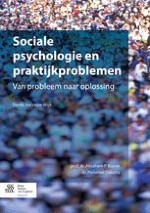2014 | OriginalPaper | Hoofdstuk
3. Van probleemstelling naar verklaringen
Auteurs : Prof. dr. Abraham P. Buunk, Dr. Pieternel Dijkstra
Gepubliceerd in: Sociale psychologie en praktijkproblemen
Uitgeverij: Bohn Stafleu van Loghum
Samenvatting
-
Formuleer de eindvariabele in termen van gedrag, affectieve reactie of attitude. Zorg ervoor dat de eindvariabele relevant is voor het aan te pakken probleem, specifiek geformuleerd wordt en bij voorkeur continu van aard is.
-
Verzamel met behulp van verschillende methoden zoveel mogelijk relevante verklaringen voor het probleem (divergente fase). Gebruik daarvoor vrije associatie, probleemassociatie, conceptassociatie, perspectiefwisseling, het waarom-interview, (zelf)observaties en sociaalpsychologische theorieën. Volg bij het zoeken naar verklaringen gebaseerd op sociaalpsychologische theorieën de volgende strategieën: onderwerpgebonden strategie, conceptuele strategie en algemene theoretische strategie.
-
Selecteer de verklaringen die elkaar niet overlappen en die relevant, valide en plausibel zijn.
